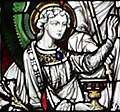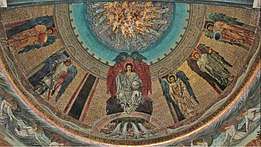Camael
Camael, also spelled Khamuel, Camiel, Cameel and Camniel, is the Archangel of strength, courage and war in Christian and Jewish mythology and angelology.
Camael | |
|---|---|
 Sanctus Chamuel, stained-glass window at St Michael's Church, Brighton, England. | |
| Archangel | |
| Venerated in | Judaism |
| Feast | 29 September |
| Attributes | Chalice, staff |
Camael is probably an alternate spelling of either חַמּוּאֵל (from chammah חַמָּה: "heat", "rage"—"anger/wrath of God")[1] or Qemuel קְמוּאֵל (from qum קוּם: "to arise", "to stand up"—"God is risen", "raised by God", "one who sees/stands before God").[2]
According to poet Gustav Davidson's popular work A Dictionary of Angels, Including the Fallen Angels (1967), he is known as one of the ten Kabbalah angels, assigned to the sephira Gevurah. Camael's name is also included in Pseudo-Dionysius' 5th or 6th century AD, Corpus Areopagiticum as one of the seven Archangels along with Michael, Gabriel, Raphael, Uriel, Jophiel, and Zadkiel.[3] He is claimed to be the leader of the forces that expelled Adam and Eve from the Garden of Eden holding a flaming sword. However, in iconography he is often depicted holding a cup.
Camael was included in the Catholic Church in the Vatican's ban on the veneration of angels not mentioned in the Bible in the Directory of Public Piety (2002).[4]
Gallery
 The Principality Camael, engraving by Crispijn van de Passe, circa 1575. Biblioteca Nacional de España, Madrid.
The Principality Camael, engraving by Crispijn van de Passe, circa 1575. Biblioteca Nacional de España, Madrid. St Chamuel in armour, detail of a stained-glass window at St Laurence Church, Meriden.
St Chamuel in armour, detail of a stained-glass window at St Laurence Church, Meriden. Archangel Chamael, stained-glass window at the Main Protestant Chapel in Marine Corps Base Camp Lejeune, Jacksonville, North Carolina.
Archangel Chamael, stained-glass window at the Main Protestant Chapel in Marine Corps Base Camp Lejeune, Jacksonville, North Carolina. Archangel Chamuel, detail of the west window at St Martin in the Bull Ring, Birmingham, England.
Archangel Chamuel, detail of the west window at St Martin in the Bull Ring, Birmingham, England. The seven archangels window, the figure on the bottom centre represents Chamuel holding in his left hand a flag bearing his attribute (chalice), and in his right hand a staff. Stained glass at St Michael and All Angels Church, Warden, Northumberland.
The seven archangels window, the figure on the bottom centre represents Chamuel holding in his left hand a flag bearing his attribute (chalice), and in his right hand a staff. Stained glass at St Michael and All Angels Church, Warden, Northumberland.
References
- Strong's Hebrew – 2536
- Strong's Hebrew – 7055
- Davidson, Gustav (1980). A Dictionary of Angels, Including the Fallen Angels. Free Press Publishing.
- Vatican Bans Rogue Angels "Chapter six deals with angels, delivering a stinging rebuff to followers of Uriel, Jophiel, Chamuel and Zadkiel, who enjoy a burgeoning reputation in New Age religions but make no appearance in the New or Old Testament."
- Furnival, William James. Leadless Decorative Tiles, Faience, and Mosaic, Comprising Notes and Excerpts on the History, Materials, Manufacture & Use of Ornamental Flooring Tiles, Ceramic Mosaic, and Decorative Tiles and Faience. Moscow: Ripol Classic Publishing House. p. 525. ISBN 978-1-176-32563-0.
While on either hand are the archangels: Michael is a glorious figure in armour; Uriel holds the sun; Gabriel bears the lily of the Annunciation; Chemuel, the angel of the Sangreal, stands next him with the sacred cup; and Zophiel, to his left, holds the moon.
Further reading
- Bamberger, Bernard Jacob, (March 15, 2006). Fallen Angels: Soldiers of Satan's Realm. Jewish Publication Society of America. ISBN 0-8276-0797-0
- Briggs, Constance Victoria, 1997. The Encyclopedia of Angels : An A-to-Z Guide with Nearly 4,000 Entries. Plume. ISBN 0-452-27921-6.
- Bunson, Matthew, (1996). Angels A to Z : A Who's Who of the Heavenly Host. Three Rivers Press. ISBN 0-517-88537-9.
- Cruz, Joan C. 1999. Angels and Devils. Tan Books & Publishers. ISBN 0-89555-638-3.
- Davidson, Gustav (1967) A Dictionary of Angels: Including the Fallen Angels. Free Press. ISBN 978-0-02-907050-5
- Graham, Billy, 1994. Angels: God's Secret Agents. W Pub Group; Minibook edition. ISBN 0-8499-5074-0
- Guiley, Rosemary, 1996. Encyclopedia of Angels. ISBN 0-8160-2988-1
- Kreeft, Peter J. 1995. Angels and Demons: What Do We Really Know About Them? Ignatius Press. ISBN 0-89870-550-9
- Lewis, James R. (1995). Angels A to Z. Visible Ink Press. ISBN 0-7876-0652-9
- Melville, Francis, 2001. The Book of Angels: Turn to Your Angels for Guidance, Comfort, and Inspiration. Barron's Educational Series; 1st edition. ISBN 0-7641-5403-6
- Ronner, John, 1993. Know Your Angels: The Angel Almanac With Biographies of 100 Prominent Angels in Legend & Folklore-And Much More! Mamre Press. ISBN 0-932945-40-6.